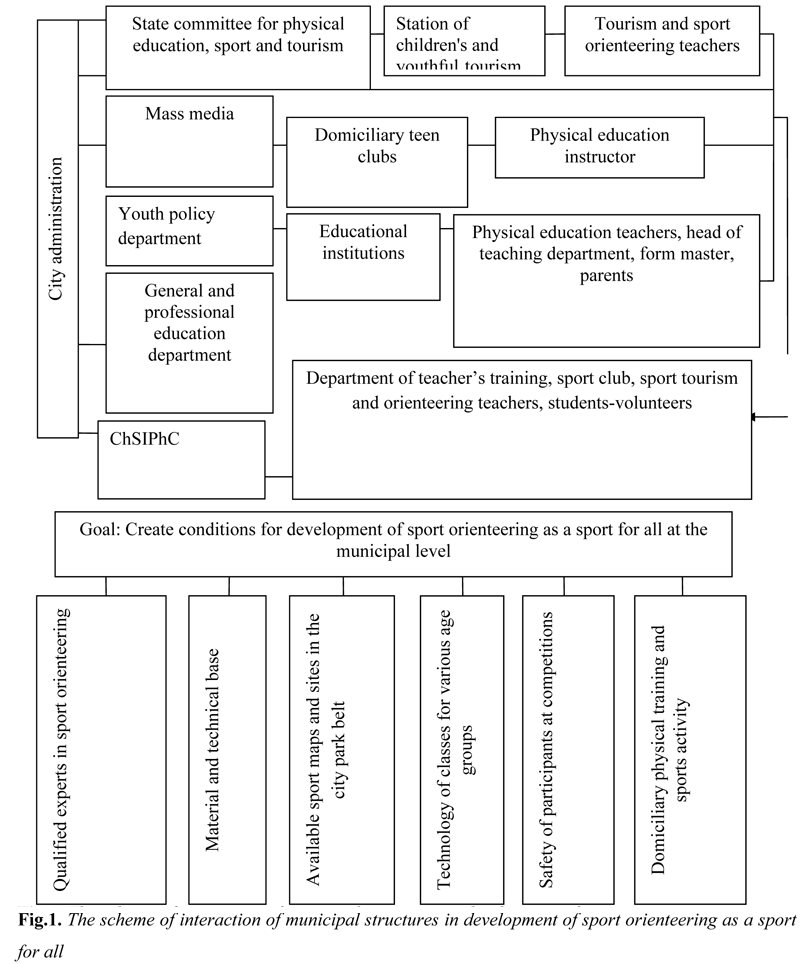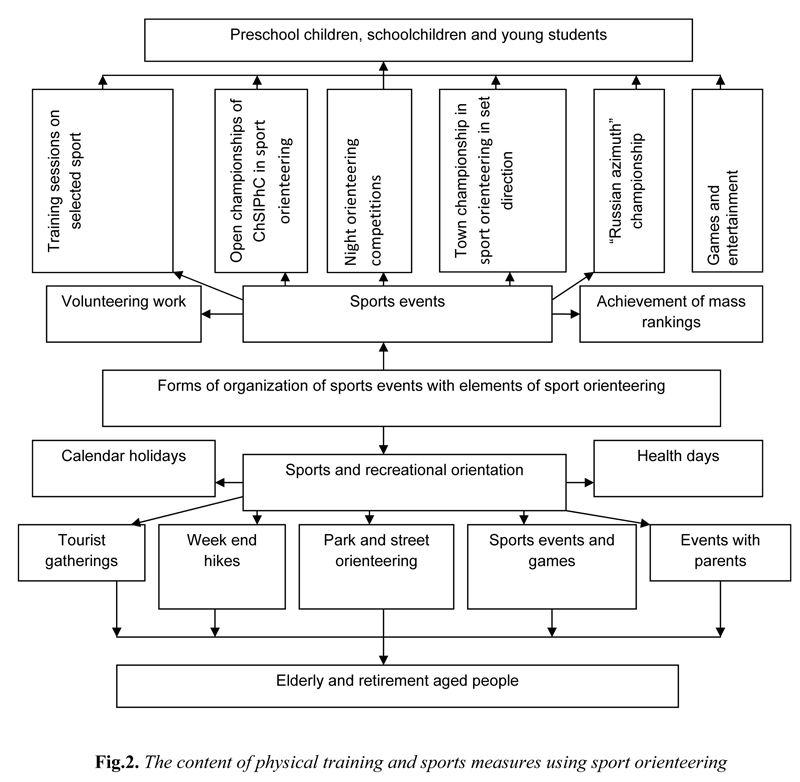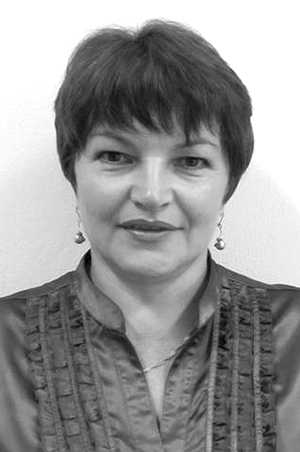Organizational and pedagogical conditions of municipal development of sports orienteering as sport for all
Фотографии:
ˑ:
Introduction. Sport orienteering belongs to mass sports and has been gaining popularity among people in the last years. The recreational efficiency of these classes has been confirmed by numerous researches [1,4]. But, notwithstanding that, problems exist, making it complicated to develop sport orienteering as a sport for all. First of all, there is a lack of science-based organizational and educational conditions to form the basic knowledge and skills of sport orienteering, weak scientific and methodological development of available orienteering modifications, that make it possible for various socio-demographic groups to participate in mass competitions [1,3,5]. At the theoretical-practical congress ”National health and mass sport” Dr.Hab, professor S.P. Evseev made a report “Innovation development of mass sport and sports science”, where he revealed his personal idea of the correlation of national health and mass sport. He marked that health is not always the value for a healthy man and, thus, in the insufficient degree serves a stimulus for young people who do not have serious health problems yet. In other words, health is important not as it is, but as a way to achieve success in life in the area which an individual considers as such for himself [2]. The main principle in our study was the personality-centered approach, where conditions for involving in sport orienteering classes of various socio-demographic groups are created at the municipal level.
The purpose of the study was to prove and experimentally check the organizational and educational conditions of development of sport orienteering as a form of physical training and sports activity at the municipal level.
Materials and methods. The set purpose was obtained using theoretical and empirical research methods such as: theoretical analysis of scientific and methodological literature, internet sources, publications on the issues of the research, studies and synthesis of teaching experience, analysis of documents, modeling, set of Q methods: questionnaire, interview, individual and group interviews. The parameters studied included interests and motives of physical training and sports activity, sport orienteering classes, along with allocation of the problems and ways of enhancement of the sports movement at the municipal level. Physical health indices were studied using the technique of S.V. Khruschev. The dynamics of control-educational tests of physical fitness and mental processes was studied based on the Yu.S. Voronov’s technique.
2 549 people aged 5-70 – residents of the city and the Chaykovsky municipal district of the Perm territory were involved in organization of the study.
Results and discussion. A poll was conducted to find out the attitude in various age groups to participation in sport orienteering competitions. Proceeding from the analysis of the findings, 26% of residents of our city are willing to “train regularly”, 45% - “participate in competitions”. It indicates to big interest of people in this kind of sports activity and a great potential of development of sport orienteering at the municipal level.
According to the analysis of subjective factors challenging representatives of various age groups to do sport orienteering, “the wish lighten their mood” was proved to be most important for 79% of primary pupils. “Feeling strong and cheerful” was marked by 88 % of secondary pupils. Senior pupils and students preferred the factor of “increase of task performance” (71–78% respectively). Regarding youth, the leading factor of classes was the “wish to do oneself well” (81%), while mature persons (83 %) called it the “way of communication”.
The findings of the preliminary study laid the basis for working the model of development of sport orienteering as a sport for all at the municipal level and the pattern of interaction of municipal structures.
The aim of development of sport orienteering as a sport for all at the municipal level is to ensure available forms of classes for all categories of citizens, regardless of their age and physical fitness.
In our study each structural unit of the model is responsible for the tasks of development of sport orienteering at the municipal level (Fig. 1). The integration of actions of municipal social structures in development of sport orienteering as a sport for all involves the interaction of city administration and General and professional education department, Committee for physical education, sport and tourism, Youth policy department, Chaykovsky state institute of physical culture and mass media.

In children’s educational institutions the system of physical education is considered as a single component of the health forming environment. In physical education elements of space orienteering are included in classes and entertainment, since this very sport has a great recreational potential.
In collaboration with the city administration the General and professional education department is elaborating the courseware to increase the qualification of teachers of extended education, trainers; develops the material and technical base of educational institutions etc.
The collaboration with the State committee for physical education, sport and tourism contributes to optimization of the physical training and sports activity of all strata of the population. Here business partnership refers to elaboration of the schedule of mass measures and sport competitions, promotion of physical culture and sport, using sports facilities and sites for sport tourism and orienteering.
The cooperation with the Committee for Youth Policy consists in organizing the work of domiciliary teen clubs. Together with sports out-of-school institutions (children’s and youth sport school, Station of children's and youthful tourism and excursions, university sports club) competitions are being held in the city micro-districts and the sites for classes of sport orienteering are being established, where everybody can do sports.
Sport orienteering is an optimal way of comprehensive studies of manifestations of physical and mental performance in the practice of physical education. As claimed by the experts [1, 4], terrain running with elements of orienteering is a more effective form of physical training of children, teenagers and youth, rather than other forms of running.
Development of sport orienteering at the municipal level was founded on the following organizational and educational principles:
- Realization of the pattern of development of sport orienteering to involve all age groups.
- Implementation of organizational and educational patterns of development of sport orienteering as a sport for all at the municipal level.
- Available qualified personnel and sports volunteers.
- Modification of technologies of sport orienteering classes based on the interest and capabilities of various age groups.
- Organization of sport orienteering competitions based on simplified rules.
- Physical training and sports activity with elements of sport orienteering organized in compliance with people’s living habits.
- Available safe conditions to hold sport orienteering competitions and equipped sites on the territory of educational institutions and in the city park belt to organize the educational-training process.
- Providing material and technical base, available sports maps to organize and hold competitions.
Forms of physical training and sports measures with elements of sport orienteering are included in sports events, sports festivals, week-end hikes (Fig. 2.).

Conclusions. It is to be marked that since 2010 orienteering competitions have been held independently by municipal organizations and educational institutions according to the subjected technique, modified for groups of various ages and physical fitness, since everybody who wishes, regardless of his physical fitness, gender or age, can participate in the competitions by the simplified rules. Such types as "Labyrinths", "Orient-show" and "Street orienteering" can be held on any sports ground, in any season and with different contingent.
For the period of the research three sport maps (of the region), firing ranges on the territories of preschool, school institutions were established in the town within the research. Sport orienteering competitions on the territory of Chaykovsky were included in the territorial schedule. Work programs for students of the institute of physical culture were designed and approved, along with the selective courses "Alternative types of orienteering", "Space orienteering", "The basics of topography and tourist orienteering", "Theory and methods of sport orienteering", "Theory and methods of the training process in sport orienteering", the subject for the teacher's college students – "The basics of topography and sport orienteering". The number of participants of mass competitions has risen, along with the forms of sports activity and competitive kinds for all population levels.
References
- Konstantinov, Yu.S. The orienteering lessons: study guide / Yu.S. Konstantinov, O.L. Glagoleva. – Moscow: FCCTRE, 2005. – 328 P. (In Russian)
- Lubysheva, L.I. Mass sport as a base of healthy national and future prosperity of Russia / L.I. Lubysheva, S.N. Litvinenko. – Moscow: Teoriya i praktika fizicheskoy kultury i sporta, 2009. – № 12. – P. 52–54. (In Russian)
- On development of sport orienteering in Russia for 2009–2020. Proceedings of the targeted program of development of sport orienteering in the RF, worked based on the law № 80 FL 29.04.1999 "On physical culture and sport in the RF". Report of the Presidium of the Sport Orienteering Federation 10.03.2009.
- Sukhanov, M.G. Sport orienteering as one of the means of training students' physical and intellectual abilities: abstract of Ph.D. thesis / M.G. Sukhanov. – Moscow, 2004. – 25 P. (In Russian)
- "Targeted program of development of sport orienteering in the Perm district for 2010–2013", adopted on the meeting of the Presidium of the Sport Orienteering Federation of the Perm district. Report № 5 October, 27 2009. (In Russian)
Author’s contacts: ph. 89225053107, lyubov.orient0203@mail.ru


